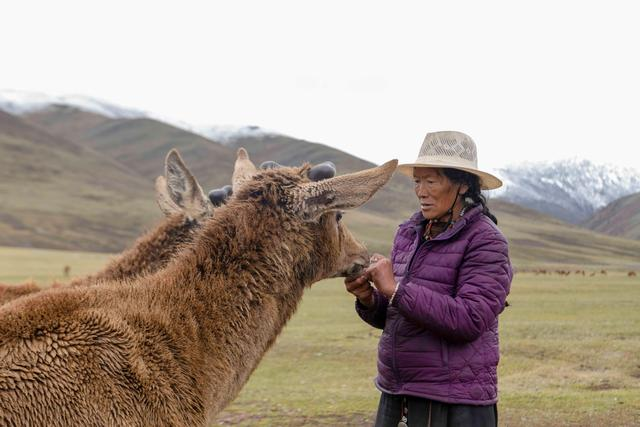
It’s 2022 now and Changchub Lhamo is 67 years old. She used to work at the Riwoche National Nature Reserve in Riwoche county in the city of Chamdo, Southwest China’s Tibet autonomous region. The reserve was set up to protect red deer. Though it has been seven years since Changchub Lhamo left her job, the former ranger(护林员) often returns to the grassland to visit her “friends”.
When Changchub Lhamo was 15 years old, she saved three deer in the wild. She found them while farming in the field. She waited all day without seeing their parents, so she decided to take them home. At that time, Changchub Lhamo’s family was not well-off. Her family didn’t have much food. But she still raised them on milk and barley(大麦). Fearing that the little red deer would catch a cold at night, Changchub Lhamo hugged them to sleep.
The three deer grew healthily under her care, and one of them was even named after her. Two years later, Changchub Lhamo released them into the wild. “I didn’t want to part with them, but I knew that nature was their home,” she said. During the first winter after their release, Changchub Lhamo was surprised to find the three red deer returning, followed by several others. The deer couldn’t find enough grassland.
The local government knew Changchub Lhamo’s story with red deer. They found a place for the deer and hired Changchub Lhamo as a ranger. In 1993, the Riwoche Red Deer Nature Reserve was established. The local government spends more than 200,000 yuan every year helping red deer survive the winter. Thanks to the protective measures, the red deer population in the reserve has risen from more than 1,000 in the 1990s to about 3,000.
Changchub Lhamo’s two sons are now among the nine rangers who work at the reserve. The rangers observe the deer, carry out regular patrols(巡逻) and rescue injured animals. “I will continue to follow in mom’s footsteps and make a contribution to wildlife protection,” said Changchub Lhamo’s son, Rinchen Tsephel.
本时文内容由奇速英语国际教育研究院原创编写,未经书面授权,禁止复制和任何商业用途,版权所有,侵权必究!(作者投稿及时文阅读定制请联系微信:18980471698)1.When did Changchub Lhamo retire?
A In 1993.
B In 2005.
C In 2013.
D In 2015.
解析:选D。D数字计算题。根据第一段最后一句的“Though it has been seven years since Changchub Lhamo left her job”可知,向秋拉姆退休七年了,因此她于(2022-7=)2015年从自然保护区管理站退休。故选D。
2.What does the underlined word “well-off” mean?
A Rich.
B Safe.
C Curious.
D Responsible.
解析:选A。A 词义猜测题。根据划线部分后面的“Her family didn’t have much food. But she still raised them on milk and barley.”可知,当时向秋拉姆家里没有太多食物,但家里人从为数不多的口粮中挤出一份,用来喂养马鹿,由此可推断当时她家并不富裕(rich)。故选A。
3.What is mainly shown in Paragraph 4?
A The red deer population both in the past and at present.
B Changchub Lhamo’s way to care for red deer.
C The local government’s efforts to protect red deer.
D The inspiration to establish the reserve.
解析:选C。C 段落大意题。1993年,西藏自治区成立类乌齐马鹿自然保护区。当地政府每年投入20多万元,用于帮助马鹿过冬。该段主要讲了当地政府为保护马鹿所做出的努力。故选C。
4.What can be inferred from the passage?
A The ranges need to take a test before working.
B Changchub Lhamo sets a good example to her sons.
C Rinchen Tsephel doesn’t understand what his mother does.
D The rangers get training in wildlife protection every day.
解析:选B。B推理判断题。根据最后一段的“Changchub Lhamo’s two sons are now among the nine rangers”以及“I will continue to follow in mom’s footsteps and make a contribution to wildlife protection”可知,向秋拉姆的儿子都追随母亲的脚步加入了保护野生动物的行列,可见母亲给他们树立了一个好榜样。故选B。